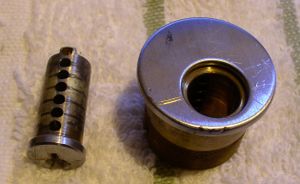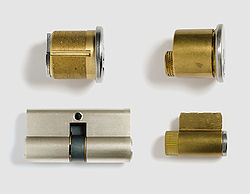Cylinder: Difference between revisions
From Lockwiki
Jump to navigationJump to search
m (→Cylinder Types: replace sidebar image (original commented out)) |
m (→Cylinder Types: caption clarity) |
||
| Line 10: | Line 10: | ||
<!--[[Image:Lockwiki_Cylinders.jpg|thumb|250px|Clockwise from top left: Mortoise, Euro, KIK, and Rim.]]--> | <!--[[Image:Lockwiki_Cylinders.jpg|thumb|250px|Clockwise from top left: Mortoise, Euro, KIK, and Rim.]]--> | ||
[[Image:cylinder types - FXE47651.jpg |thumb|250px|Clockwise from top left: mortise, rim, KIK, and euro profile]] | [[Image:cylinder types - FXE47651.jpg |thumb|250px|Clockwise from top left: mortise, rim, KIK, and euro profile cylinders]] | ||
=== Mortise === | === Mortise === | ||
Revision as of 02:57, 3 December 2022
Cylinder

A standard pin-tumbler mortoise cylinder (right).
A cylinder (or shell, housing) is a lock component which holds the plug, actuator, and locking components. Though most commonly associated with pin-tumbler based lock designs, cylinders are used in many others, such as wafer and disc-detainer.
Cylinder Types
Mortise
A threaded cylinder that screws into a door assembly and is held in place by set screws on each side.
Rim
A cylinder that is held in place by screws that extend through the cylinder itself.
Key in Knob (KIK)
A cylinder that is inserted into a knob or housing, held in place by various methods depending on the housing's design.
Euro Profile
A cylinder of a standard european format that is held in place by a screw that extends through the center of the cylinder.
See also
| This article is a stub. You can help Lockwiki by expanding it. |

